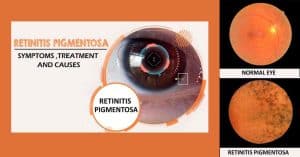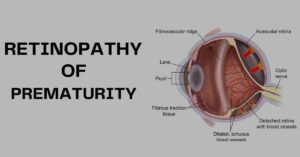Are you looking for information regarding Leber Congenital Amaurosis?
In this article, we have covered all aspects of this disease including the symptoms, causes, diagnosis, and available treatment options.
Table of Contents
ToggleWhat is Leber Congenital Amaurosis?
Leber congenital amaurosis (LCA) is a rare hereditary eye disease that is present at birth and primarily affects the retina, which is the part of the eye that is responsible for converting light into signals that are sent to the brain.
LCA is characterized by severe vision loss or blindness that occurs in infancy or early childhood. It is caused by mutations in any one of over 20 genes that are involved in the normal development and function of the retina.
How is Leber Congenital Amaurosis Inherited?
Leber congenital amaurosis (LCA) is inherited in an autosomal recessive manner. It means that an individual must inherit two copies of the mutated gene, one from each parent, in order to develop the disorder.
If a person inherits only one copy of the mutated gene, they are considered to be a carrier of the disorder and will not develop LCA. But can pass the mutation on to their children. The risk of two carrier parents having a child with LCA is 25%.
It’s important to note that LCA is a heterogeneous disorder. It means that it can be caused by mutations in any one of over 20 different genes, and each gene may have different inheritance patterns.
Some forms of LCA are inherited in an X-linked recessive manner. Which means the gene responsible for the disorder is located on the X chromosome and primarily affects males.
Other forms of LCA are inherited in an autosomal dominant manner. It means that a person only needs to inherit one copy of the mutated gene in order to develop the disorder.
What Are The Symptoms Of Leber Congenital Amaurosis?
The symptoms of Leber congenital amaurosis (LCA) vary depending on the specific gene mutation that is causing the disorder. In general, LCA is characterized by severe vision loss or blindness.
Some of the common symptoms of LCA include:
- Poor or absent vision in the first months of life
- Nystagmus, which is involuntary eye movements
- Photophobia, which is an abnormal sensitivity to light
- Strabismus, which is a misalignment of the eyes
- Reduced or absent electroretinogram (ERG) responses, which is a measure of the electrical activity of the retina
- Retinal degeneration, which can be seen in an eye examination
It’s important to note that the symptoms of LCA can be similar to those of other inherited retinal disorders. So a thorough eye examination and genetic testing are needed for a definitive diagnosis.
What Gene Causes Leber Congenital Amaurosis?
Leber congenital amaurosis (LCA) is a heterogeneous disorder, which means that it can be caused by mutations in any one of over 20 different genes.
Some of the most common genes that have been linked to LCA include RPE65, GUCY2D, RHO, AIPL1, CRB1, RPGRIP1, CEP290, RDH12, LCA5, and LCA10.
What Are The Causes Of Leber Congenital Amaurosis?
Leber congenital amaurosis (LCA) is a genetic disorder caused by mutations in any one of over 20 different genes that are involved in the normal development and function of the retina.
The most common causes of LCA are mutations in the RPE65 gene and the GUCY2D gene.
The RPE65 gene encodes an enzyme that is essential for the visual cycle in the retina. Mutations in this gene can disrupt the visual cycle, leading to severe vision loss or blindness.
The GUCY2D gene encodes a protein that is essential for the normal development and function of the retina. Mutations in this gene can disrupt the normal development of the retina, which can lead to irreversible vision loss.
Other causes of LCA include mutations in genes that are involved in the formation and maintenance of the retina. Such as the RHO gene, CRB1 gene, and RDH12 gene.
These genes are responsible for encoding proteins that are necessary for the formation of the retina, the maintenance of the retina, and the production of visual pigments.
It’s important to note that LCA can be caused by mutations in any one of over 20 different genes. Each gene may have different inheritance patterns. Genetic testing can be done to confirm the diagnosis of LCA and to identify the specific gene that is causing the disorder.
How is Leber Congenital Amaurosis Diagnosed?
Leber congenital amaurosis (LCA) is typically diagnosed based on a combination of clinical symptoms, medical history, and eye examination results. The diagnosis process may include the following steps:
Thorough Eye Examination
This includes a visual acuity test, which measures how well a person can see at different distances, and a retina examination. It can reveal degeneration or other abnormalities in the retina.
Electroretinogram (ERG) test
This test measures the electrical activity of the retina in response to light. In individuals with LCA, the ERG responses are usually reduced or absent.
Genetic testing
Genetic testing can be done to confirm the diagnosis of LCA and to identify the specific gene that is causing the disorder.
This can be done through a blood test. It may include sequencing of the known LCA-associated genes or whole exome sequencing.
It’s important to note that the symptoms of LCA can be similar to those of other inherited retinal disorders.
What Is The Treatment Options Available For Leber Congenital Amaurosis?
Currently, there is no cure for Leber congenital amaurosis (LCA).
However, there are some forms of LCA that can be treated with gene therapy. It is an experimental treatment that involves the replacement of the defective gene with a healthy copy.
Gene therapy for LCA is still in the clinical trial phase, but early results have been promising.
One of the most well-known gene therapy trials for LCA is the RPE65 gene therapy trial. It has shown positive results in improving visual function in some patients.
Other treatment options include:
Low Vision Aids
These include magnifiers, special eyeglasses, and other devices. It can help individuals with LCA to make the most of their remaining vision.
Rehabilitation
This includes training and therapy to help individuals with LCA to learn how to navigate their environment and perform daily activities.
Enzyme Replacement Therapy
This is an experimental treatment that aims to replace the missing enzyme in the retina caused by RPE65 mutations.
It’s important to note that the treatment options for LCA are limited, and the outcomes may vary depending on the specific genetic mutations and the stage of the disease.
Conclusion
Leber congenital amaurosis (LCA) is a rare inherited eye disorder. It is present at birth and primarily affects the retina. It’s characterized by severe vision loss or blindness that occurs in infancy or early childhood.
LCA is a debilitating condition that can significantly impact an individual’s quality of life. Currently, there is no cure for LCA, but some forms of LCA can be treated with gene therapy which is still in the clinical trial phase.
Low vision aids, rehabilitation, and enzyme replacement therapy are also treatment options.
Genetic counseling is also recommended for families affected by LCA to provide them with information about the disorder and the risk of it being passed on to future generations.





